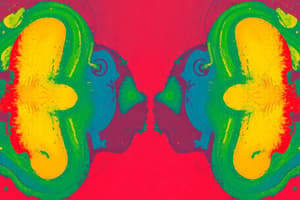Podcast
Questions and Answers
According to the social-learning viewpoint, what is the primary determinant of an individual's learning from a model?
According to the social-learning viewpoint, what is the primary determinant of an individual's learning from a model?
- The individual's attention to the model's critical features (correct)
- The model's repeated availability
- The model's physical attractiveness
- The positive incentives or rewards provided for the modeled behavior
What is the main proposition of equity theory?
What is the main proposition of equity theory?
- Individuals are motivated to exhibit modeled behaviors if they are positively reinforced
- Individuals compare their job inputs and outcomes to those of others and respond to eliminate any inequities (correct)
- Individuals are most influenced by models that are attractive, repeatedly available, important to them, or similar to them
- Individuals learn new behaviors by observing a model and then converting watching to doing
Which of the following is NOT one of the four referent comparisons in equity theory?
Which of the following is NOT one of the four referent comparisons in equity theory?
- Maslow's hierarchy of needs (correct)
- Self-outside
- Other-inside
- Self-inside
According to the social-learning viewpoint, which of the following processes demonstrates that an individual can perform modeled activities?
According to the social-learning viewpoint, which of the following processes demonstrates that an individual can perform modeled activities?
What is the key proposition of reinforcement theory?
What is the key proposition of reinforcement theory?
Which of the following is a key component of Maslow's hierarchy of needs theory?
Which of the following is a key component of Maslow's hierarchy of needs theory?
What is the main difference between positive reinforcement and negative reinforcement?
What is the main difference between positive reinforcement and negative reinforcement?
How does punishment differ from negative reinforcement?
How does punishment differ from negative reinforcement?
Extinction in the context of reinforcement theory implies:
Extinction in the context of reinforcement theory implies:
Which theory assumes that behavior is a function of consequences and also accounts for observational learning and perception?
Which theory assumes that behavior is a function of consequences and also accounts for observational learning and perception?
How does negative reinforcement differ from punishment in terms of their effects on behavior?
How does negative reinforcement differ from punishment in terms of their effects on behavior?
In the context of reinforcement theory, what does extinction refer to?
In the context of reinforcement theory, what does extinction refer to?
According to the passage, which of the following is the most relevant component of reinforcement theory for management?
According to the passage, which of the following is the most relevant component of reinforcement theory for management?
The passage mentions that 'Operant Conditioning Theory' argues that people learn to behave to get something they want or to avoid something they do not want. What does this have to do with Expectancy Theory?
The passage mentions that 'Operant Conditioning Theory' argues that people learn to behave to get something they want or to avoid something they do not want. What does this have to do with Expectancy Theory?
How does the concept of 'Positive Reinforcement' mentioned in the passage relate to Equity Theory and Organizational Justice?
How does the concept of 'Positive Reinforcement' mentioned in the passage relate to Equity Theory and Organizational Justice?
The passage mentions that 'Arousal leads to an energized state, so that the person gets 'psyched up' and performs better.' How does this relate to Maslow's Hierarchy of Needs?
The passage mentions that 'Arousal leads to an energized state, so that the person gets 'psyched up' and performs better.' How does this relate to Maslow's Hierarchy of Needs?
According to the passage, what is the purpose of using 'Positive Reinforcement' by managers?
According to the passage, what is the purpose of using 'Positive Reinforcement' by managers?




